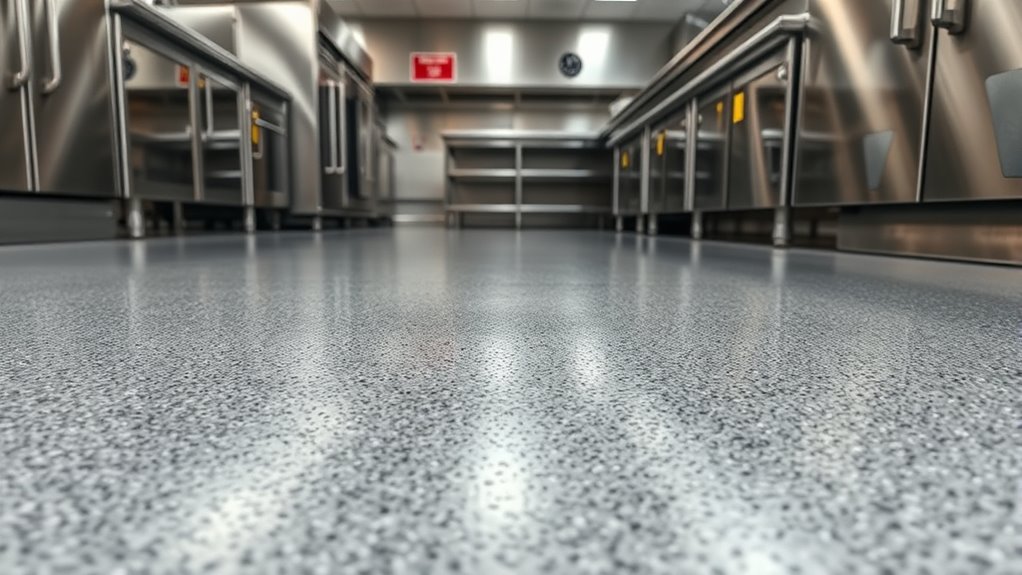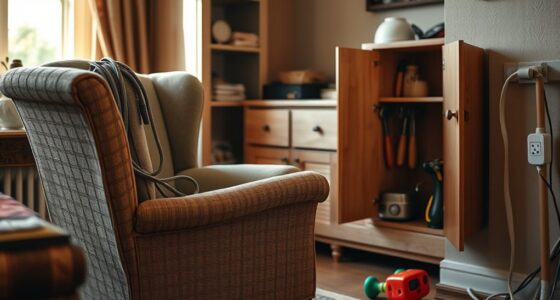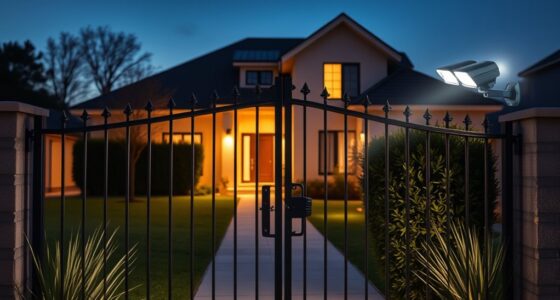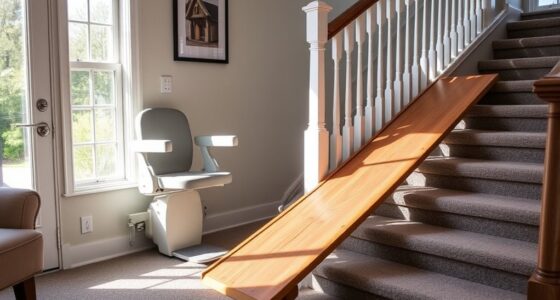To stop slips effectively, choose flooring options designed for safety, like rubber, textured vinyl, or carpet tiles, which provide excellent grip and durability. Regular cleaning and prompt spill cleanup keep surfaces slip-resistant. Outdoor areas benefit from textured concrete or stone with slip-resistant finishes. Proper maintenance and choosing the right material are key to preventing falls, so explore the best options for your space to create a safer environment—more tips await if you keep exploring.
Key Takeaways
- Choose flooring materials like rubber or textured vinyl designed for enhanced slip resistance.
- Incorporate textured surfaces or slip-resistant coatings to improve traction in high-risk areas.
- Regularly clean and maintain flooring to prevent buildup of slick residues and preserve slip resistance.
- Use slip-resistant treatments or additives for concrete and stone surfaces to improve safety outdoors.
- Install carpet tiles or mats in moisture-prone zones for additional grip and safety.
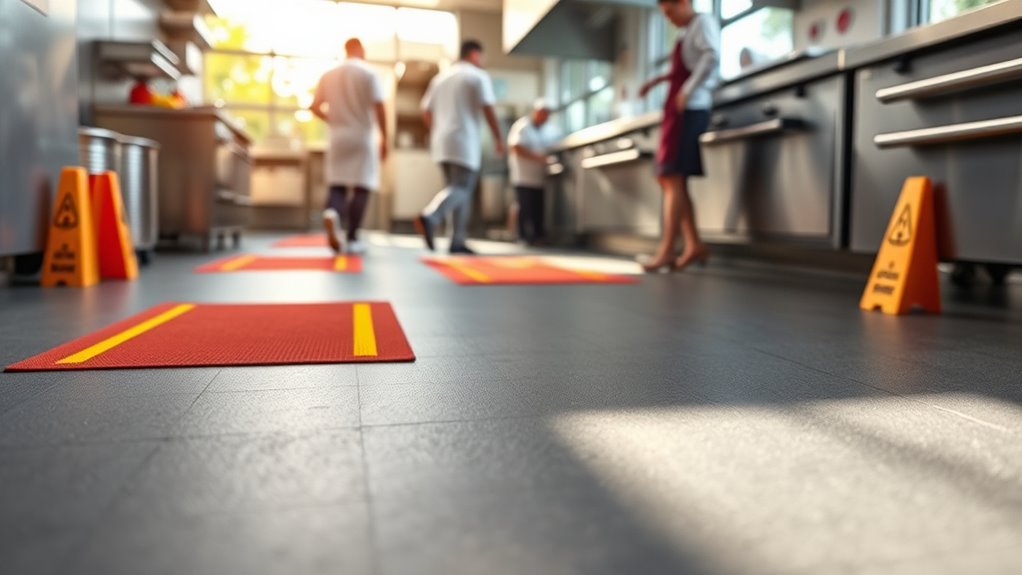
Are you concerned about slipping hazards in your home or workplace? If so, it’s essential to consider flooring options that prioritize slip resistance. The right non-slip flooring can considerably reduce accidents, especially in areas prone to moisture or spills. When choosing slip-resistant surfaces, it’s important to think about how the flooring’s texture and material contribute to overall slip resistance. A surface with good slip resistance provides better traction, even when wet or oily, making it safer for everyone. Additionally, proper flooring maintenance plays a key role in maintaining slip resistance over time. Regular cleaning ensures that dirt, grease, or other residues don’t build up and create slick patches that could lead to slips. Keeping your floors clean and well-maintained isn’t just about aesthetics—it directly impacts safety.
Prioritize slip-resistant flooring and regular cleaning to ensure safety and prevent accidents.
There are many flooring options designed with slip resistance in mind. Rubber flooring, for example, is naturally slip-resistant and resilient, making it a popular choice for gyms, kitchens, and industrial settings. Its textured surface provides excellent grip, even when wet, and it’s easy to keep clean with regular flooring maintenance. Vinyl flooring with a textured surface is another practical option. Modern vinyl comes with slip-resistant coatings or embedded particles that enhance traction without sacrificing durability. Plus, vinyl is low-maintenance, making it easier to keep slip-resistant features intact through routine cleaning. Understanding how surface texture affects slip resistance can help you select the safest flooring for your needs.
Carpet tiles can also serve as a non-slip flooring solution, especially in offices or residential spaces. They add friction underfoot, reducing the risk of slipping, and are easy to replace if damaged or stained. For outdoor spaces, textured concrete or stone pavers with slip-resistant finishes are effective, especially when combined with proper sealing and maintenance routines. These materials are durable and can withstand weather, but they require regular cleaning to prevent the buildup of moss, algae, or grime, which can compromise slip resistance.
Choosing non-slip flooring isn’t just about the initial installation—ongoing flooring maintenance is crucial to preserve slip resistance. Regular sweeping, mopping, and prompt cleanup of spills prevent dangerous slick patches. Using appropriate cleaning products designed for your flooring type helps maintain the surface’s traction properties. Remember, a well-maintained floor is a safer floor. By selecting suitable non-slip options and committing to consistent maintenance, you can create a safer environment that minimizes the risk of slips and falls, giving you peace of mind at home and work.
Frequently Asked Questions
How Durable Are Non-Slip Flooring Options Over Time?
You might wonder about non-slip flooring durability over time. Through durability testing, many options prove to withstand daily wear and tear, maintaining their slip-resistant properties. Material longevity varies, but high-quality options like rubber or treated vinyl often last for years with proper care. By choosing flooring with proven durability, you guarantee your surface stays safe and functional, even after years of heavy use.
Are Non-Slip Floors Suitable for Outdoor Use?
You can definitely use non-slip floors outdoors, as many options offer excellent weather resistance. These surfaces withstand rain, snow, and sun without deteriorating, making them perfect for patios or walkways. Plus, they come in various styles that enhance aesthetic appeal, so you don’t have to sacrifice looks for safety. Just choose a durable, weather-resistant non-slip flooring material suited for outdoor conditions, and you’ll enjoy both safety and style year-round.
What Is the Maintenance Required for Non-Slip Flooring?
You should regularly clean your non-slip flooring to maintain its safety and appearance. Use gentle cleaning requirements like sweeping or mopping with a mild detergent to prevent buildup that could reduce slip resistance. Luckily, non-slip floors come in various aesthetic options, so you can choose finishes that match your style. Routine maintenance keeps the surface effective and attractive, ensuring it continues to provide safe, stylish flooring for years to come.
How Do Non-Slip Floors Compare in Cost to Traditional Flooring?
Imagine avoiding costly slips and falls, but wonder if non-slip floors cost more upfront. The cost comparison shows non-slip flooring often has higher installation expenses due to specialized materials or treatments. However, these costs are balanced by long-term savings through reduced accident risks and maintenance. So, while initial investments may be higher, you’re likely to save money over time by prioritizing safety and durability over traditional flooring options.
Can Non-Slip Flooring Be Installed Over Existing Surfaces?
Yes, you can install non-slip flooring over existing surfaces, but it depends on the surface compatibility and the installation process. You’ll want to make certain the current floor is clean, smooth, and sturdy to provide a good base. The installation process varies based on the type of non-slip flooring chosen, but generally, it’s a straightforward way to upgrade safety without removing old flooring. Just consult professionals for best results.
Conclusion
Choosing the right non-slip flooring can truly prevent accidents and keep you safe. Some might think it’s too costly or hard to install, but investing in quality non-slip options saves you money and stress in the long run. Don’t compromise on safety—prioritize flooring that offers reliable grip and peace of mind. With the right choice, you’ll confidently move through your space, knowing slips are a thing of the past.
